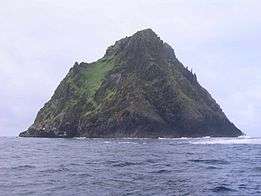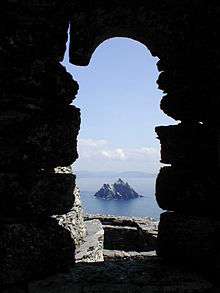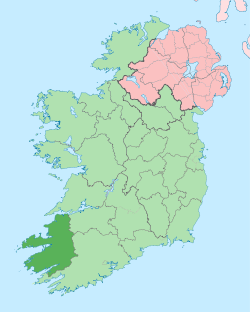Skellig Islands
Coordinates: 51°46′N 10°32′W / 51.767°N 10.533°W
|
Little Skellig, as seen through the window of a hermitage on Skellig Michael | |
 Skellig Islands | |
| Geography | |
|---|---|
| Location | Atlantic Ocean |
| Total islands | 2 |
| Major islands | |
| Administration | |
| County | Kerry |
| Demographics | |
| Population | 0 |
The Skellig Islands (Irish: Na Scealaga), once known as "the Skellocks," are two small, steep, and rocky islands lying about 13 km west of Bolus Head on the Iveragh Peninsula in County Kerry, Ireland. The larger of the two is Skellig Michael (also known as Great Skellig) and, together with Little Skellig, are at the centre of a 364 hectares (900 acres) Important Bird Area established by BirdWatch Ireland in 2000.[1] Skellig Michael is also famous for an early Christian monastery that is a UNESCO World Heritage Site.
Little Skellig
The smaller of the two islands is Little Skellig (Sceilg Bheag in Irish).[2] (grid reference V268618) It is closed to the public, and as well as being Ireland's largest northern gannet (Morus bassanus) colony with almost 30,000 pairs, it is also one of the world's largest, and is of international importance.[3] The island is 134 m tall and is approximately 1.5 km eastnortheast of Skellig Michael.
Skellig Michael
Also known as Great Skellig (Sceilg Mhichíl in Irish[4]), this is the larger of the two islands, with two peaks rising to over 230 m above sea level. With a sixth-century Christian monastery perched at 160 m above sea level on a ledge close to the top of the lower peak, Great Skellig is designated as a UNESCO World Heritage Site.
Birdwatch Ireland were concerned that the Irish government allowed filming on a seabird sanctuary without third party consent. During the 2014 nesting season, Kittiwake chicks in nests were swept into the sea by the downdraught from a helicopter and devoured by gulls. [5][6]
Wildlife
Both of the Skellig islands are known for their seabird colonies, and together comprise one of the most important seabird sites in Ireland, both for the population size and for the species diversity. Among the breeding birds are European storm petrel (Hydrobates pelagicus), northern gannet, northern fulmar (Fulmarus glacialis), Manx shearwater (Puffinus puffinus), black-legged kittiwake (Rissa tridactyla), common guillemot (Uria aalge), razorbill (Alca torda) and Atlantic puffin (Fratercula arctica) (with 4,000 or more puffins on Great Skellig alone). Red-billed chough (Pyrrhocorax pyrrhocorax) and peregrine falcon (Falco peregrinus) can also be seen.
The surrounding waters have abundant wildlife with many Grey seal (Halichoerus grypus). Basking shark (Cetorhinus maximus), minke whale (Balaenoptera acutorostrata), dolphin (Delphinidae), beaked whale, and leatherback sea turtle (Dermochelys coriacea) have also been recorded. The islands have many interesting recreational diving sites due to the clear water, an abundance of life, and underwater cliffs down to 60 meters (200 feet).
Gallery
 SE landing on Great Skellig
SE landing on Great Skellig

 Little Skellig seen from Skellig Michael
Little Skellig seen from Skellig Michael Beehive style huts on Skellig Michael
Beehive style huts on Skellig Michael
Popular culture
The Skellig islands are featured prominently in a sequence at the end of the 1976 German film Herz aus Glas (Heart of Glass) by Werner Herzog.
Irish Group Clannad wrote a song "Skellig" for their 1987 Album Sirius.
Canadian singer/songwriter Loreena McKennitt wrote the song "Skellig" for her 1997 album The Book of Secrets.
The title character of the 1998 children's book Skellig by David Almond is named for the islands.
Tristan Jones, in his sailing/travel novel ICE!, writes of a visit to the Skellig Islands en route from England to North America in 1961.[7]
The final scene of Star Wars: The Force Awakens was shot on Skellig in July 2014, with additional filming taking place there in September 2015. The remains of the Skellig Michael monastery appear in the film, representing an ancient Jedi temple.[8][9]
The Skellig Islands have also inspired the Skellige Archipelago in The Witcher novels and videogames.
The Japanese manga Berserk mentions a Skellig Island where the fictional kingdom of elves, Elfhelm, is located.
The 1969 BBC television documentary "Civilisation: A Personal View by Kenneth Clark" (Episode 1) features Skellig Michael and its monastery as an example of how, during the Dark Ages, "[For] over a hundred years, Western Christianity survived by clinging to places like this."
References
- ↑ BirdWatch Ireland. "The Skelligs: Great Skellig and Little Skellig". BirdLife International. Retrieved 19 September 2015.
- ↑ logainm.ie
- ↑ "Little Skellig, Co. Kerry". BirdWatch Ireland. Retrieved 19 September 2015.
- ↑ logainm.ie
- ↑ Star Wars: Habitats directive ‘breached’ on Skellig Michael, The Irish Times, 17 December 2015
- ↑ "Jedi threat to seabirds". New Scientist. 227 (3039): 7. 19 September 2015.
- ↑ "ICE!" by Tristan Jones ISBN 0-7592-0772-0
- ↑ O'Sullivan, Majella (29 July 2014). "And . . . action! New 'Star Wars' film shoot kicks off on Skellig Michael". Irish Independent. Independent News & Media. Retrieved 29 November 2014.
- ↑ "BirdWatch Ireland has major concerns over Star Wars filming on Skellig Michael". BirdWatch Ireland. 8 September 2015. Retrieved 19 September 2015.
External links
| Wikimedia Commons has media related to Skellig Islands. |

